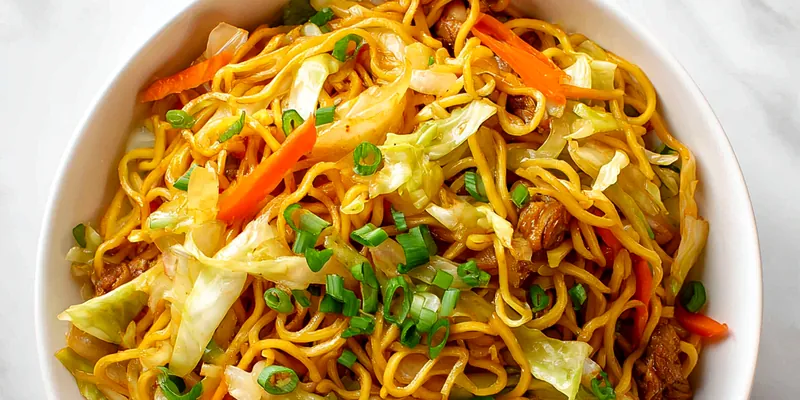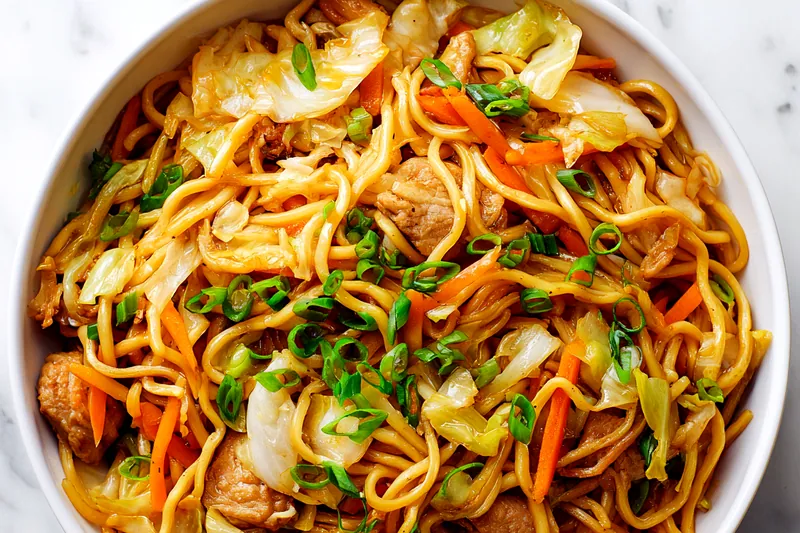Classic Stir-Fried Chow Mein Noodles
Authentic stir-fried chow mein noodles with crispy vegetables and savory sauce. Learn the secrets to perfect wok hei and restaurant-quality results at home.

Mastering the Art of Wok Cooking
The secret to exceptional chow mein lies in achieving wok hei - the distinctive smoky flavor that comes from cooking over extremely high heat. This requires proper preparation, with all ingredients prepped and ready before you start cooking, as the entire process happens very quickly.
Temperature control is crucial. The wok must be smoking hot before adding oil, and the oil should shimmer immediately upon contact. This high heat creates the characteristic slightly charred edges on vegetables while keeping them crisp-tender.
💡 Professional Tip
Never overcrowd the wok. If doubling the recipe, cook in two batches to maintain proper temperature. The vegetables should sizzle aggressively when they hit the wok.
Frequently Asked Questions
Fresh chow mein noodles are ideal, but dried lo mein or even spaghetti can work. Avoid thin noodles like angel hair as they break easily during stir-frying.
Yes, use the largest skillet or pan you have. Cast iron works well for heat retention. The key is using the highest heat your stove can produce.
Rinse cooked noodles with cold water to stop cooking, then toss with a little oil. Don't let them sit too long before stir-frying.
Absolutely! Add sliced chicken, beef, pork, or shrimp. Cook the protein first, remove it, then add back with the noodles. Tofu works great for vegetarian versions.
Bok choy, snow peas, mushrooms, or broccoli all work well. Just maintain the cooking time balance - harder vegetables go in first, softer ones last.
Usually from too low heat or overcrowding the pan. High heat evaporates moisture quickly. Also, don't add sauce until the very end of cooking.
Chow mein is best served immediately for optimal texture. You can prep all ingredients ahead, but the actual cooking should be done just before serving.
Refrigerate for up to 3 days. Reheat in a hot wok or skillet with a splash of oil to restore some crispness. Microwave will make it soggy.
Recipe Troubleshooting Guide
Noodles Breaking Apart
Problem: Noodles fall apart during stir-frying
Solution: Don't overcook noodles initially - they should be just al dente. Use gentle tossing motions rather than aggressive stirring.
Vegetables Too Soft
Problem: Vegetables lose their crunch
Solution: Increase heat and reduce cooking time. Cut vegetables uniformly so they cook evenly. Add delicate vegetables last.
Lack of Wok Hei
Problem: Missing the characteristic smoky flavor
Prevention: Use highest possible heat and ensure wok is smoking before adding ingredients. Don't move ingredients too frequently - let them char slightly.
Too Salty or Saucy
Problem: Dish is overpowered by sauce
Recovery: Add sauce gradually and taste as you go. The sauce should coat ingredients lightly, not pool in the bottom of the wok.
Uneven Cooking
Problem: Some vegetables are raw while others are overcooked
Prevention: Cut all vegetables to similar sizes and add them in order of cooking time needed - hardest vegetables first, softest last.
Flavor Balance Issues
Too Sweet: Add a pinch of white pepper or more soy sauce
Too Salty: Add a touch more sugar or a splash of rice wine
Bland: Increase garlic and ginger, or add a dash of chili oil

Selecting the Right Ingredients
Fresh chow mein noodles provide the best texture and authentic taste, but quality dried noodles work well too. Look for noodles that are slightly thick and have good elasticity to withstand the high-heat stir-frying process.
Vegetable selection is key for both flavor and visual appeal. Choose vegetables with different colors and textures - the contrast of crunchy carrots, tender cabbage, and crisp bean sprouts creates the perfect chow mein experience.
Essential Ingredient Notes
- Noodle Choice: Fresh chow mein noodles from Asian markets are ideal. If unavailable, dried lo mein noodles or even thick spaghetti can substitute.
- Dark Soy Sauce: This adds the characteristic dark color and deeper flavor. Regular soy sauce alone won't give the authentic appearance.
- Vegetable Prep: Cut vegetables uniformly for even cooking. Julienne carrots, slice peppers thin, and shred cabbage to similar widths.

The High-Heat Stir-Fry Technique
Successful chow mein requires mise en place - having everything prepared and within reach before heating the wok. Once cooking begins, there's no time to chop vegetables or mix sauces as the entire process takes less than 10 minutes.
The key to restaurant-quality results is constant motion and proper timing. Vegetables should be added in order of cooking time required, and the sauce should only be added at the very end to prevent the noodles from becoming soggy.
Perfect Wok Motion
Use a scooping and tossing motion rather than stirring. Let ingredients hit the hot wok surface briefly before tossing to develop that characteristic char.
Classic Stir-Fried Chow Mein Noodles
📋 Ingredients
For the Noodles and Vegetables
- 30ml soy sauceLight soy sauce for saltiness
- 15ml dark soy sauceFor color and deeper flavor
- 15ml oyster sauceAdds umami and slight sweetness
- 5ml sesame oilFor aromatic finishing
- 5ml sugarBalances the saltiness
- 2ml white pepperTraditional Chinese seasoning
For the Sauce
- 450g fresh chow mein noodlesOr dried lo mein noodles
- 45ml vegetable oil, dividedHigh smoke point oil essential
- 2 cloves garlic, mincedFresh garlic for aromatic base
- 15g fresh ginger, mincedEssential for authentic flavor
- 1 medium onion, slicedCut into thin strips
- 2 carrots, juliennedCut into matchstick pieces
- 200g cabbage, shreddedAdds crunch and volume
Instructions
Prepare the Noodles
Cook noodles according to package directions until just tender. Drain, rinse with cold water, and toss with 1 tablespoon oil to prevent sticking. Set aside.
Mix the Sauce
In a small bowl, combine soy sauce, dark soy sauce, oyster sauce, sesame oil, sugar, and white pepper. Stir until sugar dissolves. Set aside.
Stir-Fry Vegetables
Heat wok or large skillet over high heat until smoking. Add 1 tablespoon oil, then add garlic and ginger, stir-fry for 30 seconds. Add onion, carrots, and bell pepper. Stir-fry for 2-3 minutes.
Add Remaining Vegetables
Add cabbage and bean sprouts to the wok. Stir-fry for another 2 minutes until vegetables are crisp-tender. Push vegetables to one side of wok.
Combine and Finish
Add remaining oil to empty side of wok, then add noodles. Pour sauce over noodles and toss everything together vigorously for 2-3 minutes. Add green onions, toss once more, and serve immediately garnished with sesame seeds.
Recipe Notes & Tips
Wok Hei Tips
For best results, use the highest heat setting on your stove and ensure the wok is smoking hot before adding ingredients. The characteristic smoky flavor comes from this extreme heat.
Noodle Alternatives
If fresh chow mein noodles aren't available, dried lo mein works well. In a pinch, thick spaghetti or linguine can substitute, though the texture will be slightly different.
Customization
Add your favorite protein like chicken, beef, shrimp, or tofu. Cook protein first, remove from wok, then add back with noodles. Adjust vegetables based on preference and availability.
